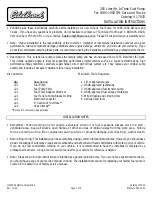
Belts should be inspected for evidence of cuts, cracks,
glazing, or frayed cords and replaced if there is indication
of damage which could result in belt failure. Low gen-
erator belt tension can cause battery failure.
Also check belt routing to make sure there is no interfer-
ence between the belts and other engine components.
Spark Plugs
Spark plugs must fire properly to assure engine perfor-
mance and emission control. New plugs should be in-
stalled at the specified mileage. The entire set should be
replaced if there is any malfunction due to a faulty spark
plug. Malfunctioning spark plugs can damage the cata-
lytic converter. For proper type of replacement spark
plugs, refer to the “Vehicle Emission Control Informa-
tion” label in the engine compartment.
Engine Air Cleaner Filter
Under normal driving conditions, replace the air filter at
the intervals shown on Schedule “A”. If, however, you
drive the vehicle frequently under dusty or severe con-
ditions, the filter element should be inspected periodi-
cally and replaced if necessary at the intervals shown on
Schedule “B”.
WARNING!
The air cleaner can provide a measure of protection
in the case of engine backfire. Do not remove the air
cleaner unless such removal is necessary for repair or
maintenance. Make sure that no one is near the
engine compartment before starting the vehicle with
the air cleaner removed. Failure to do so can result in
serious personal injury.
Fuel Filter
A plugged fuel filter can cause stalling, limit the speed at
which a vehicle can be driven or cause hard starting.
Should an excessive amount of dirt accumulate in the
fuel tank, filter replacement may be necessary. See your
local dealer for service.
Catalytic Converter
The catalytic converter requires the use of unleaded fuel
only. Leaded gasoline will destroy the effectiveness of the
catalyst as an emission control device.
MAINTAINING YOUR VEHICLE
287
7
Summary of Contents for 2005 LX Magnum
Page 2: ......
Page 5: ...INTRODUCTION 5 1...
Page 8: ......
Page 81: ...UNDERSTANDING THE FEATURES OF YOUR VEHICLE 81 3...
Page 82: ...82 UNDERSTANDING THE FEATURES OF YOUR VEHICLE...
Page 83: ...UNDERSTANDING THE FEATURES OF YOUR VEHICLE 83 3...
Page 131: ...INSTRUMENTS AND CONTROLS UNDERSTANDING YOUR INSTRUMENT PANEL 131 4...
Page 132: ...STANDARD INSTRUMENT CLUSTER 132 UNDERSTANDING YOUR INSTRUMENT PANEL...
Page 133: ...PREMIUM INSTRUMENT CLUSTER UNDERSTANDING YOUR INSTRUMENT PANEL 133 4...
Page 191: ...UNDERSTANDING YOUR INSTRUMENT PANEL 191 4...
Page 195: ...Operating Tips UNDERSTANDING YOUR INSTRUMENT PANEL 195 4...
Page 196: ......
Page 227: ...STARTING AND OPERATING 227 5...
Page 265: ...WHAT TO DO IN EMERGENCIES 265 6...
Page 275: ...2 7L ENGINE MAINTAINING YOUR VEHICLE 275 7...
Page 276: ...3 5L ENGINE 276 MAINTAINING YOUR VEHICLE...
Page 277: ...5 7L ENGINE MAINTAINING YOUR VEHICLE 277 7...
Page 322: ......
Page 348: ......
Page 349: ...INDEX 10...
Page 363: ...NOTES...
Page 364: ...NOTES...
Page 365: ...NOTES...
Page 366: ...NOTES...
Page 367: ...NOTES...
Page 368: ...NOTES...
















































